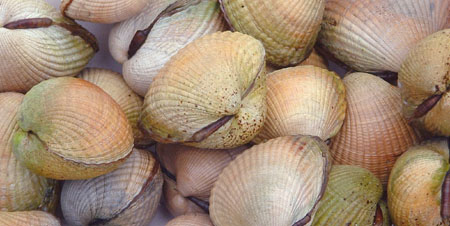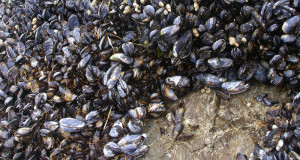On the way home from work yesterday I had a driveway moment and could not stop listening to a story on All Things Considered on the benefits of forgoing the pub this Sunday and instead preparing some heartwarming Irish food at home to celebrate Erin go bragh. The story featured a recipe – Molly Malone’s Cockle and Mussel Chowder – from Rachel Allen, a popular Irish TV Chef, and I got to thinking on how I think it’s time to briefly feature those bivalves on Beach Chair Scientist! Here are 5 facts about cockles and mussels so you can have some fodder if you like to pretend to be the host of a show while cooking for your family.
Cockles
- There are more than 200 species of cockles.
- Cockles have a distinct rounded, heart-shaped shell with ribs that fan out through the length of the shell (they’re actually evenly spaced on the exterior of the shell).
- Cockles prefer intertidal areas with sand and mud beaches and depths up to 60 feet. Cockles are distributed world-wide, but the common cockle (Cerastoderma edule) is found widely distributed around the coastlines of Northern Europe (extending west to Ireland, the Barents Sea in the north, Norway in the east, and as far south as Senegal).
- Cockles move with a powerful muscular foot. They’ve even been witnessed springing with this strong foot on the bottom of the ocean floor.
- Cockles are not important commercially.
Mussels
- Mussels have wedged-shaped, asymmetrical shell that is longer than wide. They’re typically dark blue, blackish, or brown, while the interior is silvery and somewhat nacreous.
- Mussels are filter feeders and feed on plankton and other microscopic, free-floating sea creatures in seawater.
- Mussels provide shelter and protection from heat, desiccation, and predators for many smaller marine organisms.
- According to Wired, “Chemists recently made prototype bandages with an inkjet printer filled with adhesive proteins taken from mussels, whose remarkable “feet” — a tangle of fibers that anchor them to rocks — have made them the most widely studied specialist in marine clinging”.
- 90% of the world’s mussels are cultured, with the major producers being China, Spain, Italy, Thailand, France, and New Zealand. Don’t fret, the U.S. has tough regulations on its imports of mussels.
Click here for the lyrics to the Irish song Cockles and Mussels, or Molly Malone. Erin go bragh!









Speak Your Mind